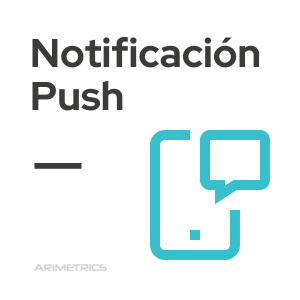 Definition
Definition
A push notification is an alert that is sent to a mobile device, either Android or iOS, directly from an app or website, without the recipient having to open or visit it to receive it. This functionality has been consolidated as an effective marketing strategy in the last decade due to the growth in the use of smartphones and apps.
These push notifications allow organizations to use a key advantage in their campaigns: providing relevant and useful information to the user, even when they are not interacting with the mobile app or website. They can be used to inform about new messages, promotions, updates, reminders of important events, relevant news and much more. In addition, unlike email marketing or other types of notifications, push notifications have a significantly high open rate.
How Push Notifications Work
Push notifications, sometimes referred to as “push notifications” or “pop-up notifications,” are messages that are sent from a specific server, such as Firebase Cloud Messaging for Android or Apple Push Notification Service for iOS, to a specific device without active user intervention. The process can be summarized in the following steps:
- Registration: When you install an app or agree to receive notifications from a website, the system generates a unique identifier. With the active subscription, this identifier is communicated to a push notification server.
- Sending the notification: Depending on the configuration and the type of push notifications you want to send (promotions, updates, reminders, among others), the server processes the information and sends it to the registered devices.
- Reception and interaction: The user receives the notification in his browser or mobile device and can interact with it, either by opening it to access the content or discarding it.
Types of Push Notifications
Mobile push notifications and web push notifications vary depending on content and purpose:
- Message notifications: Mainly used in messaging apps like WhatsApp.
- Promotion notifications: Organizations use push notifications to promote special offers directly on users’ devices.
- Update notifications: These pushes are usually automatic and notify the user about new versions available.
- Reminder notifications: They can remember medical appointments, meetings, or birthdays.
Practices for sending push notifications
Sending push notifications effectively is essential. It is essential to segment and personalize each message for each user, based on their behavior and preferences. Frequency is crucial: While receiving a single weekly push notification can be effective, receiving 46 push notifications a day can be overwhelming.
The key to push notifications lies in their relevance and the value they offer to the user, so it is vital to measure and analyze the results to optimize future campaigns.
Advantages of Push Notifications
Among the benefits of push notifications we can mention:
- Immediacy: Push notifications are received in real time, allowing the user to be informed of events, updates or news instantly.
- High open rate: Compared to other mediums like email, push notifications tend to have higher open rates.
- Personalization: They can be customized according to user behavior and preferences, which makes them more relevant and effective.
- Increased retention: They serve to reengage you with users who have not interacted with an application or website in a while.
- Delivery efficiency: Unlike other media, where the message can be lost or classified as spam, push notifications arrive directly to the user’s device.
- Lower cost: Compared to other forms of marketing, sending push notifications is usually cheaper.
Drawbacks of Push Notifications
Push notifications can backfire because of the following:
- Saturation: An excess of notifications can be annoying for the user, leading him to disable them or even uninstall the application.
- Intrusiveness: If not managed correctly, they can be perceived as intrusive or invasive, affecting the user’s perception of the brand.
- Subscription dependency: The user must give explicit permission to receive push notifications. Without that consent, it is not possible to reach him through this channel.
- Content limitations: Unlike other formats, push notifications have a limit on how much text or content they can display.
- Possibility of being ignored: If they do not add value or relevance, users can begin to ignore them, reducing their effectiveness.
- Technical difficulties: In some cases, compatibility problems with certain devices or operating systems may arise, or the need for technical adjustments to ensure their correct delivery.
It is essential to weigh these advantages and disadvantages when considering push notifications as part of a communication or marketing strategy. The key is to use them effectively, ensuring that they add value to the user and avoiding saturation.
